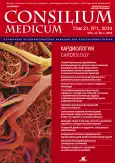Age aspects of acute myocardial infarction
- Authors: Khorolets E.V.1, Shlyk S.V.1, Bychkova O.I.1,2
-
Affiliations:
- Rostov State Medical University of the Ministry of Health of the Russian Federation
- Department of the Federal Security Service in the Volgograd region
- Issue: Vol 21, No 1 (2019)
- Pages: 31-35
- Section: Articles
- URL: https://journals.rcsi.science/2075-1753/article/view/96880
- DOI: https://doi.org/10.26442/20751753.2019.1.180087
- ID: 96880
Cite item
Full Text
Abstract
Keywords
Full Text
##article.viewOnOriginalSite##About the authors
Ekaterina V. Khorolets
Rostov State Medical University of the Ministry of Health of the Russian Federation
Email: kata_maran@mail.ru
D. Sci. (Med.), Teaching Assistant in Department of Internal Medicine of Advanced Training and Professional Retraining Faculty 29, per. Nakhichevanskii, Rostov-on-Don, 344022, Russian Federation
Sergey V. Shlyk
Rostov State Medical University of the Ministry of Health of the Russian Federation
Email: sshlyk@mail.ru
D. Sci. (Med.), Prof., Head of the Department of Internal Medicine of Advanced Training and Professional Retraining Faculty 29, per. Nakhichevanskii, Rostov-on-Don, 344022, Russian Federation
Olga I. Bychkova
Rostov State Medical University of the Ministry of Health of the Russian Federation; Department of the Federal Security Service in the Volgograd region
Email: bychkova_006@mail.ru
Cand. Sci. (Med.), Lt. Colonel of Medical Corps, Medical Service corps officer 29, per. Nakhichevanskii, Rostov-on-Don, 344022, Russian Federation
References
- Чазов Е.И. Пути снижения смертности от сердечно-сосудистых заболеваний. Терапевтический архив. 2008; 8: 6-11.
- Hjemdahl P, Eriksson S.V, Held C et al. Favorable long term prognosis instable angina pectoris: an extended follow up of the angina prognosis study in Stockholm (APSIS). Heart 2006; 92: 177-82.
- Di Angelantonio E, Chowdhury R, Sarwar N et al. Chronic kidney disease and risk of major cardiovascular disease and non-vascular mortality: prospective population based cohort study. BMJ 2010; 341: 49-86.
- Wilson P.W, Sr.D’Agostino R, Bhatt D.L et al. An international model to predict recurrent cardiovascular disease. Am J Med 2012; 125: 695-703.
- Zucker I.H, Xiao L, Haack K.K. The central renin-angiotensin system and sympathetic nerve activity in chronic heart failure. Clin Sci (Lond) 2014; 126 (10): 695-706.
- Troughton R, Michael Felker G, Januzzi J.L.Jr. Natriuretic peptide-guided heart failure management. Eur Heart J 2014; 35 (1): 16-24.
- Argmann C.A, Van Den Diepstraten C.H, Sawyez C.G et al. Transforming growth factor-beta 1 inhibits macrophage cholesterol ester accumulation induced by native and oxidized VLDL remnants. Arterioscler Thromb Vasc Biol 2001; 21 (12): 2011-8.
- Kleczyński P, Legutko J, Rakowski T et al. Predictive utility of NT-pro BNP for infarct size and left ventricle function after acute myocardial infarction in long-term follow-up. Dis Markers 2013; 34 (3): 199-204.
- Голухова Е.З., Теряева Н.Б., Алиева А.М. Натрийуретические пептиды - маркеры и факторы прогноза при хронической сердечной недостаточности. Креативная кардиология. 2007; 1-2: 126-36.
- Kempf T, Zarbock A, Widera C et al. GDF-15 is an inhibitor of leukocyte integrin activation required for survival after myocardial infarction in mice. Nature Medicine 2011; 17 (5): 581-8. doi: 10.1038/nm.2354
- Xu J. GDF15/MIC-1 functions as a protective and antihypertrophic factor released from the myocardium in association with SMAD protein activation. Circulation Res 2006; 98 (3): 342-50. doi: 10.1161/01.res.0000202804.84885.d0
- Bonaca M.P, Morrow D.A, Braunwald E et al. Growth Differentiation Factor-15 And Risk Of Recurrent Events In Patients Stabilized After Acute Coronary Syndrome: Observations From PROVE IT-TIMI 22. Arterioscler Thromb Vasc Biol 2011; 31 (1): 203-10. doi: 10.1161/atvbaha.110.213512
- Kempf T, Sinning J.M, Quint A et al. Growth differentiation factor-15 for risk stratification in patients with stable and unstable coronary heart disease: results from the AtheroGene study. Circ Cardiovasc Genet 2009; 2 (3): 286-92. doi: 10.1161/circgenetics.108.824870
- Баллюзек М.Ф., Гриненко Т.Н., Кветной И.М. Гормоны сердца в формировании сердечно-сосудистой патологии. Клин. медицина. 2005; 11: 4-12.
- Бугримова М.А., Савина Н.М., Ваниева О.С. и др. Мозговой натрийуретический пептид как маркер и фактор прогноза при хронической сердечной недостаточности. Кардиология. 2006; 1: 51-7.
- Kikuta K, Yasue H, Yoshimura M et al. Increased plasma levels of B-type natriuretic peptide in patients with unstable angina. Am Heart J 1996; 132 (1; Pt. 1): 101-7.
- Januzzi J.L. Natriuretic peptide testing: A window into the diagnosis and prognosis of heart failure. Cleveland Clin J Med 2006; 73: 149-57.
- Januzzi J.L, Camargo C.A, Anwaruddins S et al. The N-Terminal Pro-BNP Investigation of Dyspnea in the Emergency Department (PRIDE) Study. Am J Card 2005; 95: 948-54.
- James S.K, Lindahl B, Siegbahn A et al. N-terminal pro-brain natriuretic peptide and other risk markers for the separate prediction of mortality and subsequent myocardial infarction in patients with unstable coronary artery disease: a Global Utilization of Strategies To Open occluded arteries (GUSTO)-IV substudy. Circulation 2003; 108 (3): 275-81.
- Remme W.J, Swedberg K. European Society of Cardiology. Comprehensive guidelines for the diagnosis and treatment of chronic heart failure. Task force for the diagnosis and treatment of chronic heart failure of the European Society of Cardiology. Eur J Heart Fail 2002; 1: 11-22.
- Galasko G.I, Lahiri A, Barnes S.C et al. What is the normal range for N-terminal pro-brain natriuretic peptide? How well does this normal range screen for cardiovascular disease? Eur Heart J 2005; 26 (21): 2269-76.
- Komajda M, Lam C.S. Heart failure with preserved ejection fraction: a clinical dilemma. Eur Heart J 2014; 35 (16): 1022-32.
- Van Veldhuisen D.J, Linssen G.C, Jaarsma T et al. B-type natriuretic peptide and prognosis in heart failure patients with preserved and reduced ejection fraction. J Am Coll Cardiol 2013; 61 (14): 1498-506.
- Schlittenhardt D, Schober A, Strelau J et al. Involvement of Growth Differentiation Factor-15. Macrophage Inhibitory Cytokine 1 (GDF-15/MIC-1) in oxLDL-induced Apoptosis of Human Macrophages in vitro and in Arteriosclerotic Lesions. Cell Tissue Res 2004; 318 (2): 325-34.
Supplementary files






